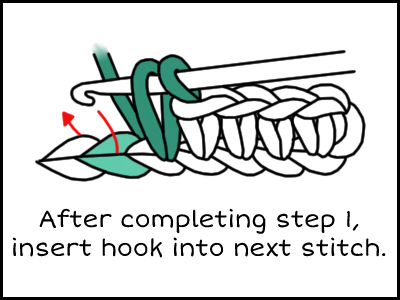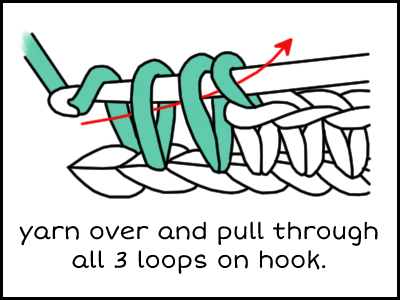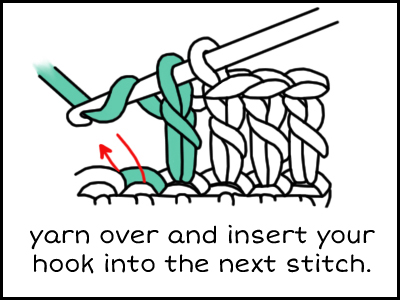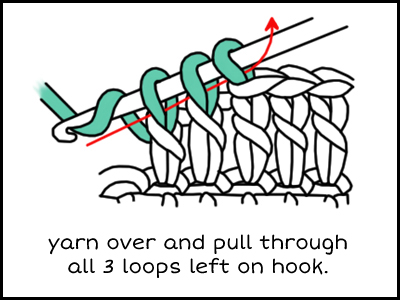Abbreviations
dec
2sc/dc/tr together
dec
2sc/dc/tr together
Like increasing, decreasing alters the shape of our piece. Rather than making the piece bigger like increases, decreases make our pieces smaller. You use these two techniques as a way to manipulate the piece your working on to create the diverse shapes we see in amigurumi and other projects.
Just as the name implies we’re going to be removing stitches from a row. This is a little more difficult than increasing, but we’ll take it one step at a time. For each one of these stitches start with a piece 10 stitches long with 2 rows. Just to give you some working room.
1. Insert your hook into next stitch, yarn over, and pull through. 2 loops on hook.
2. Insert your hook into the next stitch, yarn over, and pull through. 3 loops on hook.
3. Yarn over, pull through all 3 loops on your hook. Congrats! You’ve just made a decrease!
Make a regular sc, then make another dec. Continue practicing every other stitch as a decrease. Notice how it’s shaping your piece.
Invisible Decreases are amazing to use on amigurumi. The upside is that invisible decreases are less noticeable. Ever get a large gap when you decrease? This technique will cut that down! Instead of decreasing through both loops of your piece, only stitch through the front loops. This simple step reduces the look of the decrease by allowing that back row to kind of “fill in” that space. You’ll still get that decrease, but it’ll be prettier.


I won’t be going over all the stitches but since double crochet is a common stitch outside of amigurumi I thought I would throw it in. So go ahead and get a practice row of double crochets going, about 12 will do.
Creating a decrease with double crochet starts halfway through the first stitch.
1. Yarn over hook. Insert hook into stitch, yarn over, and pull through.
2. Yarn over. Pull through first 2 loops on stitch. 2 loops remain on hook.
(Here is where we start our decrease)
3. Yarn over. Insert hook into the next stitch, yarn over, and pull through.
4. Yarn over. Pull through the first 2 loops on hook. You should have 3 loops on the hook.
5. Yarn over and pull through the remaining 3 loops on your hook. Congrats, you’ve just decreased a double crochet!
Go ahead and keep practicing your double crochet decreases. Decrease every other stitch like the single crochet practice.


Notice how we keep the height on a double crochet piece despite decreasing it. Decreasing double crochets and triple crochets are a bit more complicated. It’s a lot of steps. But if you practice and keep in mind the height of a stitch, it’s an easy and logical process!

Practice your decreases, especially the single crochet decrease.
Create a single crochet piece 16 stitches long. (Chain 17) Give yourself a few rows of single crochets. Then every other stitch start practicing your decreases.
Repeat with a double crochet piece 16 stitches long. Give yourself a few rows of double crochets. Then start decreasing every other stitch. Even if you think you won’t be using this stitch any time soon it’s important to commit this to memory now while it’s fresh. It’ll make stitching later on much easier!
What is decreasing?
A – Removing a row from a piece.
B – Adding a stitch.
C – Combining two stitches together.
My row contains 16 stitches. My pattern has me decreasing 4 times in the next row. How many stitches will I end up with at the end?
A – 16
B – 14
C – 12
D – 10
C!
What have you been doing this entire lesson?!
C!
Decreasing is essentially removing stitches. So if we decrease 4 times, then we are removing 4 stitches. 16-4 = 12
Recent Comments